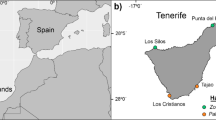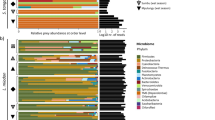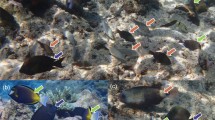Abstract
Understanding species-specific resource requirements is paramount in managing and protecting biodiversity in a world where environmental quality is in decline. Dietary data can inform predator–prey relationships and how changes in prey availability impact different species. However, for many coral reef fishes, prey and predatory events can be difficult to observe and identify, both in situ and within examined stomach samples. Here we applied DNA metabarcoding of stomach content samples for 11 Red Sea butterflyfish species to identify the diversity of dietary components that these primarily benthic feeding fish consume across coral reefs. Detections based on 18S and COI sequences from partially digested stomach contents significantly increased the resolution and diversity of the known diet for this group of fish, which included cryptic prey that are difficult to visually document due to soft parts or morphological ambiguity. In addition to scleractinian corals and other Cnidaria, the obligate corallivore species fed on a wide range of benthic organisms, whereas facultative species displayed a broader diet with crustaceans, tunicates, and worms contributing to samples. While a number of individuals contained DNA that could not be confidently identified using this method, the proportion of unidentifiable sequences was relatively low across butterflyfish species. The COI marker identified the importance of soft corals in the diet for two hard coral specialists; Chaetodon melannotus and Chaetodon semilarvatus, with soft coral detected in over half of the individuals and contributing significantly to the number of DNA sequence reads within their gut. Notably, five prey items identified to the species level were detected that are currently not documented in the Red Sea. Our analysis revealed that the diet of different species of butterflyfish significantly overlaps, with all species deriving most of their diet from the phylum Cnidaria (hard and soft coral, anemones) and symbiotic Symbiodiniaceae algae. Furthermore, accumulation curves suggest that all study species may feed on an even greater fraction of the benthos, likely driven by the availability and diversity of each individual/pair’s territory. This approach increases the known dietary resolution and diversity of these key reef fishes and further enhances our understanding of the relationship between butterflyfish and benthic organisms.





Similar content being viewed by others
Data availability
All data are provided within the manuscript and supporting tables. Raw sequencing data are available from the Dryad Digital Repository: TBA. https://doi.org/10.5061/dryad.4b8gthtdb
References
Alwany M, Hanafy M, Kotb M, Gab-Alla A (2007) Species Diversity and Habitat Distribution of Fishes in Sharm El-Maiya Bay, Sharm El-Sheikh, Red Sea. Catrina: The International Journal of Environmental Sciences 2:83–90
Alwany M, Thaler E, Stachowitsch M (2003) Food selection in two corallivorous butterflyfishes, Chaetodon austriacus and C. trifascialis, in the northern Red Sea. Marine Ecology 24:165–177
Amarasekare P (2008) Spatial dynamics of foodwebs. Annual Review of Ecology, Evolution, and Systematics 39:479–500
Appeltans W, Ahyong ST, Anderson G, Angel MV, Artois T, Bailly N, Bamber R, Barber A, Bartsch I, Berta A, Błażewicz-Paszkowyc M (2012) The magnitude of global marine species diversity. Current Biology 22:2189–2202
Bell J, Galzin R (1984) Influence of live coral cover on coral-reef fish communities. Marine Ecology Progress Series 15:265–274
Bell J, Harmelin-Vivien M, Galzin R (1985) Large scale spatial variation in abundance of butterflyfishes (Chaetodontidae) on Polynesian reefs. Proc 5th Int Coral Reef Symp 5:421–426
Bellwood DR, Hughes TP, Folke C, Nyström M (2004) Confronting the coral reef crisis. Nature 429:827–833
Berumen ML, Hoey A, Bass WH, Bouwmeester J, Catania D, Cochran J, Khalil MT, Miyake S, Mughal M, Spaet JL (2013) The status of coral reef ecology research in the Red Sea. Coral Reefs 32:737–748
Bouchon-Navaro Y (1985) Impact of coral degradation on a chaetodontid fish assemblage (Moorea, French Polynesia). Proc 5th Int Coral Reef Symp 5:427–432
Boyer F, Mercier C, Bonin A, Le Bras Y, Taberlet P, Coissac E (2016) obitools: A unix-inspired software package for DNA metabarcoding. Molecular Ecology Resources 16:176–182
Boyer S, Brown SD, Collins RA, Cruickshank RH, Lefort M-C, Malumbres-Olarte J, Wratten SD (2012) Sliding window analyses for optimal selection of mini-barcodes, and application to 454-pyrosequencing for specimen identification from degraded DNA. PLoS One 7:e38215
Bozec Y, Dolédec S, Kulbicki M (2005) An analysis of fish-habitat associations on disturbed coral reefs: chaetodontid fishes in New Caledonia. Journal of Fish Biology 66:966–982
Burgar JM, Murray DC, Craig MD, Haile J, Houston J, Stokes V, Bunce M (2014) Who’s for dinner? High-throughput sequencing reveals bat dietary differentiation in a biodiversity hotspot where prey taxonomy is largely undescribed. Molecular Ecology 23:3605–3617
Cadoret L, Adjeroud M, Tsuchiya M (1999) Spatial distribution of chaetodontid fish in coral reefs of the Ryukyu Islands, southern Japan. Journal of the Marine Biological Association of the United Kingdom 79:725–735
Casey JM, Meyer CP, Morat F, Brandl SJ, Planes S, Parravicini V (2019) Reconstructing hyperdiverse food webs: gut content metabarcoding as a tool to disentangle trophic interactions on coral reefs. Methods in Ecology and Evolution 10:1157–1170
Casey JM, Ransome E, Collins AG, Mahardini A, Kurniasih EM, Sembiring A, Schiettekatte NM, Cahyani NK, Wahyu Anggoro A, Moore M, Uehling A (2021) DNA metabarcoding marker choice skews perception of marine eukaryotic biodiversity. Environmental DNA 6:1229–1246
Castro P (1978) Movements between coral colonies in Trapezia ferruginea (Crustacea: Brachyura), an obligate symbiont of scleractinian corals. Marine Biology 46:237–245
Chao A, Ma K, Hsieh T (2016) User’s guide for iNEXT online: software for interpolation and Extrapolation of species diversity. Code 30043:1–14
Clarke K, Gorley R (2015) Getting started with PRIMER v7. PRIMER-E: Plymouth, Plymouth Marine Laboratory
Clements KD, German DP, Piché J, Tribollet A, Choat JH (2017) Integrating ecological roles and trophic diversification on coral reefs: multiple lines of evidence identify parrotfishes as microphages. Biological Journal of the Linnean Society 120:729–751
Coker DJ, Wilson SK, Pratchett MS (2014) Importance of live coral habitat for reef fishes. Reviews in Fish Biology and Fisheries 24:89–126
Cole AJ, Pratchett MS, Jones GP (2008) Diversity and functional importance of coral-feeding fishes on tropical coral reefs. Fish and Fisheries 9:286–307
Conradi M, Bandera E, Mudrova SV, Ivanenko VN (2018) Five new coexisting species of copepod crustaceans of the genus Spaniomolgus (Poecilostomatoida: Rhynchomolgidae), symbionts of the stony coral Stylophorapistillata (Scleractinia). ZooKeys 71
de Bruyn M, Barbato M, DiBattista JD, Broadhurst MK (2021) Secondary predation constrains DNA-based diet reconstruction in two threatened shark species. Scientific Reports 11:1–11
Deagle BE, Chiaradia A, McInnes J, Jarman SN (2010) Pyrosequencing fecal DNA to determine diet of little penguins: is what goes in what comes out? Conservation Genetics 11:2039–2048
Deagle BE, Thomas AC, McInnes JC, Clarke LJ, Vesterinen EJ, Clare EL, Kartzinel TR, Eveson JP (2019) Counting with DNA in metabarcoding studies: how should we convert sequence reads to dietary data? Molecular Ecology 28:391–406
DiBattista JD (submitted) Seawater eDNA and dietary metabarcoding provide insights into corallivorous butterflyfish and their reef environments.
Dormann CF, Gruber B, Fründ J (2008) Introducing the bipartite package: Analysing ecological networks. R News 8:8–11
Duffy JE, Cardinale BJ, France KE, McIntyre PB, Thébault E, Loreau M (2007) The functional role of biodiversity in ecosystems: incorporating trophic complexity. Ecology Letters 10:522–538
Edgar R (2010) Usearch. Lawrence Berkeley National Lab, Berkeley, CA
Emslie M, Pratchett M, Cheal A, Osborne K (2010) Great Barrier Reef butterflyfish community structure: the role of shelf position and benthic community type. Coral Reefs 29:705–715
Enochs IC, Manzello DP (2012) Species richness of motile cryptofauna across a gradient of reef framework erosion. Coral Reefs 31:653–661
Fowler AJ (1990) Spatial and temporal patterns of distribution and abundance of chaetodontid fishes at One Tree Reef, southern GBR. Marine Ecology Progress Series 64:39–53
Friedlander AM, Sandin SA, DeMartini EE, Sala E (2010) Spatial patterns of the structure of reef fish assemblages at a pristine atoll in the central Pacific. Marine Ecology Progress Series 410:219–231
Frøslev TG, Kjøller R, Bruun HH, Ejrnæs R, Brunbjerg AK, Pietroni C, Hansen AJ (2017) Algorithm for post-clustering curation of DNA amplicon data yields reliable biodiversity estimates. Nature Communications 8:1–11
Gariepy T, Kuhlmann U, Gillott C, Erlandson M (2007) Parasitoids, predators and PCR: the use of diagnostic molecular markers in biological control of Arthropods. Journal of Applied Entomology 131:225–240
Glynn PW (2004) High complexity food webs in low-diversity Eastern Pacific reef–coral communities. Ecosystems 7:358–367
Goatley C, Bellwood DR (2009) Morphological structure in a reef fish assemblage. Coral Reefs 28:449–457
Gregson M, Pratchett M, Berumen ML, Goodman B (2008) Relationships between butterflyfish (Chaetodontidae) feeding rates and coral consumption on the Great Barrier Reef. Coral Reefs 27:583–591
Harmelin-Vivien M, Bouchon-Navaro Y (1983) Feeding diets and significance of coral feeding among chaetodontid fishes in Moorea (French Polynesia). Coral Reefs 2:119–127
Harmelin-Vivien ML (2002) Energetics and fish diversity. The Ecology of Fishes on Coral Reefs 265–274
Harms-Tuohy CA, Schizas NV, Appeldoorn RS (2016) Use of DNA metabarcoding for stomach content analysis in the invasive lionfish Pterois volitans in Puerto Rico. Marine Ecology Progress Series 558:181–191
Hiatt RW, Strasburg DW (1960) Ecological relationships of the fish fauna on coral reefs of the Marshall Islands. Ecological Monographs 30:65–127
King R, Read D, Traugott M, Symondson WOC (2008) Molecular analysis of predation: a review of best practice for DNA-based approaches. Molecular Ecology 17:947–963
LaJeunesse TC, Parkinson JE, Gabrielson PW, Jeong HJ, Reimer JD, Voolstra CR, Santos SR (2018) Systematic revision of Symbiodiniaceae highlights the antiquity and diversity of coral endosymbionts. Current Biology 28:2570–2580
Lawton RJ, Cole AJ, Berumen ML, Pratchett MS (2012) Geographic variation in resource use by specialist versus generalist butterflyfishes. Ecography 35:566–576
Lawton RJ, Pratchett MS (2012) Influence of dietary specialization and resource availability on geographical variation in abundance of butterflyfish. Ecology and Evolution 2:1347–1361
Leray M, Agudelo N, Mills SC, Meyer CP (2013a) Effectiveness of annealing blocking primers versus restriction enzymes for characterization of generalist diets: unexpected prey revealed in the gut contents of two coral reef fish species. PLoS One 8:e58076
Leray M, Yang JY, Meyer CP, Mills SC, Agudelo N, Ranwez V, Boehm JT, Machida RJ (2013b) A new versatile primer set targeting a short fragment of the mitochondrial COI region for metabarcoding metazoan diversity: application for characterizing coral reef fish gut contents. Frontiers in Zoology 10:1–14
Melville AJ, Connolly RM (2003) Spatial analysis of stable isotope data to determine primary sources of nutrition for fish. Oecologia 136:499–507
Mouillot D, Villéger S, Parravicini V, Kulbicki M, Arias-González JE, Bender M, Chabanet P, Floeter SR, Friedlander A, Vigliola L (2014) Functional over-redundancy and high functional vulnerability in global fish faunas on tropical reefs. Proceedings of the National Academy of Sciences 111:13757–13762
Mouillot D, Villéger S, Scherer-Lorenzen M, Mason NW (2011) Functional structure of biological communities predicts ecosystem multifunctionality. PLoS One 6:e17476
Mousavi-Derazmahalleh M, Stott A, Lines R, Peverley G, Nester G, Simpson T, Zawierta M, De La Pierre M, Bunce M, Christophersen CT (2021) eDNAFlow, an automated, reproducible and scalable workflow for analysis of environmental DNA sequences exploiting Nextflow and Singularity. Molecular Ecology Resources 21:1697–1704
Murray DC, Bunce M, Cannell BL, Oliver R, Houston J, White NE, Barrero RA, Bellgard MI, Haile J (2011) DNA-based faecal dietary analysis: a comparison of qPCR and high throughput sequencing approaches. PLoS One 6:e25776
Murray DC, Coghlan ML, Bunce M (2015) From benchtop to desktop: important considerations when designing amplicon sequencing workflows. PLoS One 10:e0124671
Nagelkerken I, Van der Velde G, Wartenbergh S, Nugues M, Pratchett M (2009) Cryptic dietary components reduce dietary overlap among sympatric butterflyfishes (Chaetodontidae). Journal of Fish Biology 75:1123–1143
Niedermüller S, Schiemer L, Herler J (2009) Food selection of a corallivorous butterflyfish Chaetodon austriacus in the Red Sea, with particular emphasis on size and fish symbionts of corals. Journal of Fish Biology 75:1496–1504
Obuchi M, Kogo I, Fujita Y (2009) A new brooding feather star of the genus Dorometra (Echinodermata: Crinoidea: Comatulida: Antedonidae) from the Ryukyu Islands, southwestern Japan. Zootaxa 2008:61–68
Pääbo S, Poinar H, Serre D, Jaenicke-Després V, Hebler J, Rohland N, Kuch M, Krause J, Vigilant L, Hofreiter M (2004) Genetic analyses from ancient DNA. Annual Reviews Genetics 38:645–679
Parravicini V, Casey JM, Schiettekatte NM, Brandl SJ, Pozas-Schacre C, Carlot J, Edgar GJ, Graham NA, Harmelin-Vivien M, Kulbicki M (2020) Delineating reef fish trophic guilds with global gut content data synthesis and phylogeny. PLoS Biology 18:e3000702
Pimm SL, Raven P (2000) Extinction by numbers. Nature 403:843–845
Pochon X, Bott NJ, Smith KF, Wood SA (2013) Evaluating detection limits of next-generation sequencing for the surveillance and monitoring of international marine pests. PLoS One 8:e73935
Pompanon F, Deagle BE, Symondson WO, Brown DS, Jarman SN, Taberlet P (2012) Who is eating what: diet assessment using next generation sequencing. Molecular Ecology 21:1931–1950
Porter TM, Hajibabaei M (2018) Scaling up: a guide to high-throughput genomic approaches for biodiversity analysis. Molecular Ecology 27:313–338
Pratchett M, Berumen M (2008) Interspecific variation in distributions and diets of coral reef butterflyfishes (Teleostei: Chaetodontidae). Journal of Fish Biology 73:1730–1747
Pratchett M, Gust N, Goby G, Klanten S (2001) Consumption of coral propagules represents a significant trophic link between corals and reef fish. Coral Reefs 20:13–17
Pratchett MS (2005) Dietary overlap among coral-feeding butterflyfishes (Chaetodontidae) at Lizard Island, northern Great Barrier Reef. Marine Biology 148:373–382
Pratchett MS (2007) Dietary selection by coral-feeding butterflyfishes (Chaetodontidae) on the Great Barrier Reef, Australia. Raffles Bulletin of Zoology 14:171–176
Pratchett MS, Berumen ML, Kapoor B (2013) Biology of butterflyfishes. CRC Press
Pratchett MS, Blowes SA, Coker D, Kubacki E, Nowicki J, Hoey A (2015) Indirect benefits of high coral cover for non-corallivorous butterflyfishes. Coral Reefs 34:665–672
Pratchett MS, Munday PL, Wilson SK, Graham NA, Cinner JE, Bellwood DR, Jones GP, Polunin NV, McClanahan TR (2008) Effects of climate-induced coral bleaching on coral reef fishes ecological and economic consequences. Oceanography and Marine Biology. CRC Press, pp 257–302
Pratchett MS, Wilson S, Baird A (2006) Declines in the abundance of Chaetodon butterflyfishes following extensive coral depletion. Journal of Fish Biology 69:1269–1280
Pratchett MS, Wilson SK, Berumen ML, McCormick MI (2004) Sublethal effects of coral bleaching on an obligate coral feeding butterflyfish. Coral Reefs 23:352–356
Reimer JD, Biondi P, Lau YW, Masucci GD, Nguyen XH, Santos ME, Wee HB (2019) Marine biodiversity research in the Ryukyu Islands, Japan: current status and trends. PeerJ 7:e6532
Rotjan RD, Lewis SM (2008) Impact of coral predators on tropical reefs. Marine Ecology Progress Series 367:73–91
Roughgarden J (1983) Competition and theory in community ecology. American Naturalist 122:583–601
Sandin SA, Smith JE, DeMartini EE, Dinsdale EA, Donner SD, Friedlander AM, Konotchick T, Malay M, Maragos JE, Obura D (2008) Baselines and degradation of coral reefs in the Northern Line Islands. PLoS One 3:e1548
Sazima C, Sazima I (2001) Plankton-feeding aggregation and occasional cleaning by adult butterflyfish, Chaetodon striatus (Chaetodontidae), in southwestern Atlantic. Cybium 25:145–151
Schneider MF (2001) Habitat loss, fragmentation and predator impact: spatial implications for prey conservation. Journal of Applied Ecology 38:720–735
Schubert M, Lindgreen S, Orlando L (2016) AdapterRemoval v2: rapid adapter trimming, identification, and read merging. BMC Research Notes 9:1–7
Sheppard S, Harwood J (2005) Advances in molecular ecology: tracking trophic links through predator–prey food-webs. Functional Ecology 19:751–762
Stat M, Huggett MJ, Bernasconi R, DiBattista JD, Berry TE, Newman SJ, Harvey ES, Bunce M (2017) Ecosystem biomonitoring with eDNA: metabarcoding across the tree of life in a tropical marine environment. Scientific Reports 7:1–11
Steffan-Dewenter I, Tscharntke T (2000) Butterfly community structure in fragmented habitats. Ecology Letters 3:449–456
Symondson W (2002) Molecular identification of prey in predator diets. Molecular Ecology 11:627–641
Valentini A, Pompanon F, Taberlet P (2009) DNA barcoding for ecologists. Trends in Ecology & Evolution 24:110–117
Van Soest RW, Boury-Esnault N, Vacelet J, Dohrmann M, Erpenbeck D, De Voogd NJ, Santodomingo N, Vanhoorne B, Kelly M, Hooper JN (2012) Global diversity of sponges (Porifera). PLoS One 7:e35105
Wilson SK, Graham NA, Pratchett MS, Jones GP, Polunin NV (2006) Multiple disturbances and the global degradation of coral reefs: are reef fishes at risk or resilient? Global Change Biology 12:2220–2234
Wrathall TJ, Roberts CM, Ormond RF (1992) Territoriality in the butterflyfish Chaetodon austriacus. Environmental Biology of Fishes 34:305–308
Zekeria Z, Dawit Y, Ghebremedhin S, Naser M, Videler J (2002) Resource partitioning among four butterflyfish species in the Red Sea. Marine and Freshwater Research 53:163–168
Acknowledgements
We would like to acknowledge the field support of Malek Amr Gusti, Dream Divers, KAUST Coastal and Marine Resources Core Lab, and all the fish that were sampled for this project. This study was funded by baseline research funds to M.L.B, ARC Linkage Project (LP160100839) to J.D.D., M.S., and M.B., as well as a Curtin University Early Career Research Fellowship (ECRF) to J.D.D. This work was also supported by the Pawsey Supercomputing Centre with funding from the Australian Government and the Government of Western Australia. The authors would like to acknowledge Matthew Power and Megan Coghlan for DNA sequencing assistance, as well as Mahsa Mousavi-Derazmahalleh for assistance with the eDNAFlow pipeline.
Author information
Authors and Affiliations
Corresponding author
Ethics declarations
Conflict of interest
On behalf of all authors, the corresponding author states that there is no conflict of interest.
Ethical approval
This research was undertaken in accordance with the policies and procedures of the King Abdullah University of Science and Technology (KAUST) Institutional Animal Care and Use Committee (IACUC#17-04-006, IACUC#17-04-007). Permissions relevant for KAUST to undertake the research was obtained from the applicable governmental agencies (Government Affairs, Regional Coastguard) in the Kingdom of Saudi Arabia.
Additional information
Publisher's Note
Springer Nature remains neutral with regard to jurisdictional claims in published maps and institutional affiliations.
Topic Editor Steve Vollmer
Supplementary Information
Below is the link to the electronic supplementary material.
Rights and permissions
Springer Nature or its licensor holds exclusive rights to this article under a publishing agreement with the author(s) or other rightsholder(s); author self-archiving of the accepted manuscript version of this article is solely governed by the terms of such publishing agreement and applicable law.
About this article
Cite this article
Coker, D.J., DiBattista, J.D., Stat, M. et al. DNA metabarcoding confirms primary targets and breadth of diet for coral reef butterflyfishes. Coral Reefs 42, 1–15 (2023). https://doi.org/10.1007/s00338-022-02302-2
Received:
Accepted:
Published:
Issue Date:
DOI: https://doi.org/10.1007/s00338-022-02302-2




